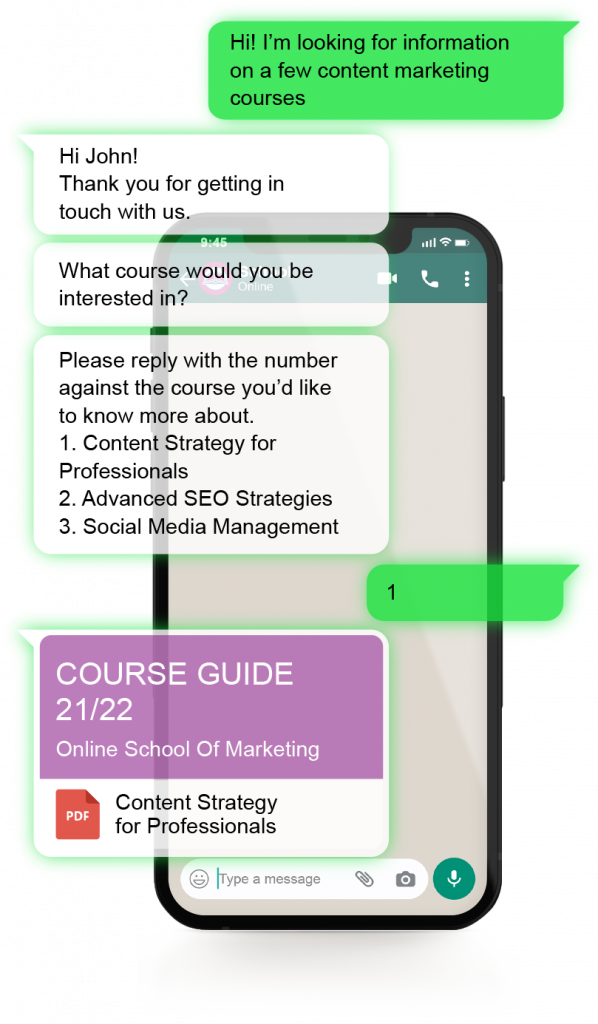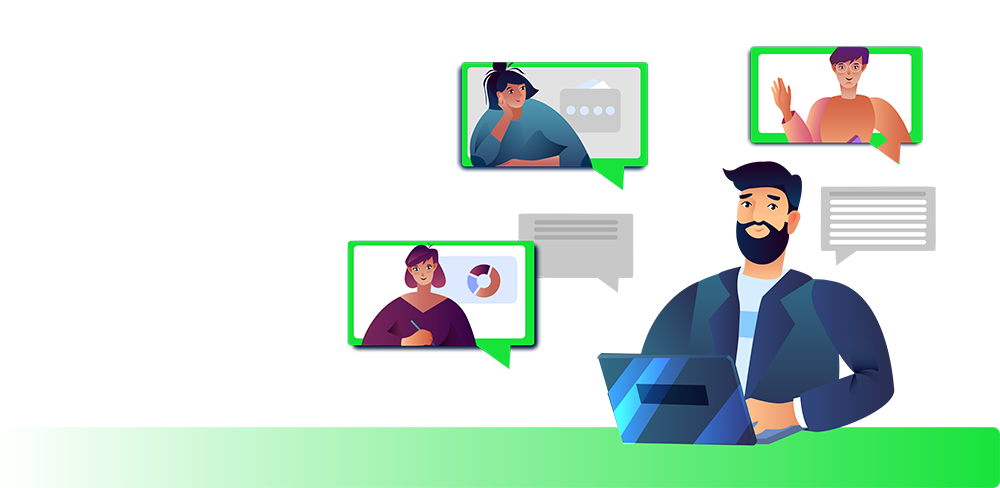How Messaging Tools Are Meeting the Changing Needs of the Education Sector

Online learning has shown significant traction over the last decade. Even before Covid-19 hit the world
in 2020, e-learning was on the rise with the online education market slated to reach $350 billion by 2025. A number of online learning platforms like Masterclass, Udemy, and LinkedIn Learning had been offering professional courses across a range of verticals. Learners would simply need to subscribe online and start learning on a professional platform. Top-tier universities offered online learning programs to students across the globe. Language apps like DuoLingo were extremely popular with millions globally. Yet, schools and universities had largely stuck to the traditional, offline mode of learning. The covid-19 pandemic changed that.
Overnight, schools and colleges were forced to shut down and teachers were left scrambling to come up with ways that would somehow ensure continuity of education. Turning to digital technologies was an obvious choice. As most schools did not have their own learning platforms, they teamed up with technology companies that provided online portals which would enable remote learning. This forged unique partnerships between schools and technology companies to open up online learning environments for students overnight.
Communication Platforms – Closing the Gap Between Students and Other Stakeholders
Despite the presence of online learning platforms, however, a gap was felt when it came to enabling daily communication between the students / parents and institutions. Information that was readily available on-premise, i.e., when a student went to their school or college – things like class timetables, exam dates, etc., became difficult to access once the institutions closed. Students would have to call up institutes, look up their websites, email them, or log into portals for information on day-to-day changes. This precipitated the need for online messaging platforms like WhatsApp, Live Chat, Push, and SMS as a means to enable real-time communication between different stakeholders.
The primary benefit of using such technologies was their accessibility. For students in developing nations, participating in digital learning was a challenge as most students did not have access to a laptop. Being primarily mobile-based experiences, they were easily available to students, especially in developing nations where most students could not afford laptops. Mobile phones helped to close the gap between privileged and disadvantaged students, with many governments distributing free mobile phones among students. In Pakistan, for instance, the ITA program ‘Siyani Sahelian – Advancing Action for Adolescent Girls’ supported teachers to create WhatsApp groups of students in clusters.

Use Cases of Messaging Platforms in Education
Messaging technologies, which were never created with education in mind, have turned out to be boon for the sector. Their popularity has increased despite the presence of other dedicated, purposebuilt learning platforms. Messaging, which is already popular with people and widely accessible as its a mobile-first experience, has helped the sector transcend geographical challenges and connected teachers and students in real time. In the wake of school closures, messaging tools like WhatsApp have presented themselves as the most immediate medium to connect students with teachers. Its rich features including text, audio and video have also created more equitable learning opportunities for children with different learning needs. Also, as these technologies can be easily integrated with learning management systems, teachers get a comprehensive view of all their online interactions with students, no matter through which channel, and take action accordingly. Messaging platforms serve a variety of needs. Let’s look at some use cases:
Use Case #1: Onboarding New Students
Problems
Educational institutions often face issues in getting prospective students interested in a course. They might share information about a course on their web page or even flyer, or even ask students for their email IDs for sending them course descriptions, but these are not often engaging enough for students to express interest. The result? Prospective students lost to competing institutions, resulting in loss of revenue. Also, once prospective students have expressed interest, they request information on the admissions process and need to complete a number of admission-related steps. This becomes inconvenient when institutions are closed.
Approach / Solution
Instead of expecting students to look up the institute’s website, email, or call up to seek admissions-related information, institutions can make it easier for students by having an official WhatsApp account and inviting students to opt-in to initiate conversations with admission officials. Students can simply give a missed call to their college/institute’s WhatsApp number – giving their consent to be contacted via WhatsApp. Interested students can have their queries answered over chat, institutions can share admission forms on WhatsApp, and students can even upload filled-in admission forms on the app itself.
Live chat can also be an effective medium for turning prospective students into actual ones. Chat widgets on a web page enable students or parents reach out to the institution for a variety of queries. Live chat, whether automated, or with a human agent, helps prospective students not just with answering initial queries, but also in gauging their interests and guiding them toward a suitable course.
Benefits
- Streamlines the application process and saves
time for both students and institutes - Facilitates real-time, one-to-one high-quality
interactions - Increases students’ accessibility to information
on available courses and admission criteria - Support teams can help multiple students
simultaneously over chat - Better first impression and increased
competitiveness - Results in increased enrollment
User Type
- New students or parents who are seeking
information on available courses

Onboarding Framework
| Customer Need | To seek information on courses |
| Communication Intent | To help applicants find out which courses are available, to answer all queries on the admissions process (such as eligibility for the course, course fee, etc.), keep them up-todate about the status of their application, schedule in-person interviews if needed, provide information on faculty, share class schedules, enable candidates to upload filled up forms, etc. |
| Channel | WhatsApp, Live Web Chat, SMS |
| Type of Communication | Two-way for WhatsApp and one-way for SMS and live chat |
| Mode of Communication | Fully automated messages; or automated as well as live agent support over messaging |
| Admission Deadline Reminder Trigger | 15 days before deadline, 7 days before appointment, 24 hours before deadline |
| Conversion Goal | WhatsApp Opt-In, lead generation, lead conversion, and segmentation |
| edna Features Implemented | Create onboarding flow with customer journey orchestration, Trigger messages, Campaign messages, WhatsApp Business API, Live Web Chat SDK, Cascading |
| Systems Connected | Learning management systems, integrated school management software |
Use Case #2: Nurturing Students Via Personalized Messages
Problems
Once students have enrolled and the admissions process is over, their progress on a particular course needs to be monitored on a daily basis. How they are faring, whether they are facing any difficulties in following the course material, in submitting documents, having their doubts cleared, etc. This becomes a hassle as educational institutes are not always able to reach out to students and get them to respond. With emails, there is a strong possibility that students might not open them, or may simply choose not to respond to them. Not nurturing the student-teacher or student institute relationship may have adverse consequences in that students may drop out of courses.
Approach / Solution
Students’ progress can be effectively monitored over messaging platforms like WhatsApp that enable easy two-way communication. Institutes can simply drop a message for students on WhatsApp asking if they are having any difficulties in following the course, etc. and students can respond as per their convenience. WhatsApp video calling can help students reach out to teachers to get their doubts cleared. This helps institutions gauge the student’s progress and nurture relationships. Young students can undertake assessments under the supervision of their parents at home, and share images of their work with teachers on WhatsApp. Push notifications are also helpful in this regard as they can gently nudge learners to leave feedback about their experience on the institute’s learning app.
Benefits
- Students can reach out to teachers from the comfort of their homes
- Teachers can monitor a student’s learning progress, share personalized feedback on a student’s
strengths and areas of improvement, recommend alternative courses - Institutes can provide a personalized approach to on-campus counselling
User Type
- Students who are already enrolled to a course
Onboarding Framework
| Customer Need | To help students throughout the course of their studies |
| Communication Intent | To help students clear their doubts with teachers, submit assignments, take video lessons, create study groups, share feedback, send admit cards, course timetables, share feedback forms with students, career advice, etc. |
| Channel | WhatsApp, Push |
| Type of Communication | Two-way for WhatsApp, One-way for Push |
| Mode of Communication | Fully automated messages; or automated as well as live agent support over messaging |
| Course-Related Reminder Triggers | Assignment deadlines triggers, Lecture timetable triggers |
| Conversion Goal | WhatsApp Opt-In, relationship building, CSI |
| edna Features Implemented | Trigger messages, Campaign bulk messages, WhatsApp Business API, Push SDKs |
| Systems Connected | Learning management systems, integrated school management software |

Use Case #3: Sustaining Professional Development of Teaching Staff During Lockdown
Problems
The pandemic has put an enormous strain on teachers, as they not only had to ensure continuity of their students’ education, but also had to find ways to continue their own trainings and workshops to improve their own teaching methods. With teachers’ training institutes shut down, teachers faced huge difficulties in finding ways that would enable them to continue their learning.
Approach / Solution
WhatsApp can be leveraged as a platform on which a modified set of courses can be shared with teachers. Teachers can be grouped under different subjects, and course material can be shared as JPEG or PDF files. The platform can also facilitate discussions among teachers where they share their own experiences in classrooms, exchange best practices, and support each other.
Benefits
- Allows teachers’ training institutes to carry out teacher’s professional development unhindered
- Enables teachers to learn online and share their learnings with other educators
User Type
- Teachers and institutes looking for more efficient ways to complete teacher’s professional training
Onboarding Framework
| Customer Need | To enable teachers’ professional developmen |
| Communication Intent | To help teachers receive training materials, exam schedules, etc. online |
| Channel | WhatsApp, SMS |
| Type of Communication | Two-way for WhatsApp, One-way for SMS |
| Mode of Communication | Fully automated messages; or automated as well as live agent support over messaging |
| Training Reminder Trigger | Training schedule reminders, announcement/notice triggers |
| Conversion Goal | WhatsApp Opt-In, training completion rates |
| edna Features Implemented | WhatsApp Business API, edna cascading, edna platform |
| Systems Connected | Learning management systems |
Use Case #4: Using Automation to Respond to Repetitive Queries Faster
Problems
Institutes face hundreds of repetitive queries from students as well as parents – those pertaining to exam dates, assignment submission deadlines, and so on. Responding to each of them manually, whether over phone or email, is a huge drain on time and resources. Moreover, they have to send many outbound messages such as fee reminders, new course announcements, etc. on a daily basis. Doing all this manually is next to impossible and there is the serious risk of students missing out on crucial information.
Approach / Solution
Institutes can use automated chatbots on their WhatsApp and Live Chat platforms to reduce the burden on teachers as well as admin staff when it comes to answering routine queries. Rules-based bots are designed to answer general queries and help students complete a variety of self-service tasks like uploading application forms, answer general queries on course modules, time tables, important dates, etc. They can collect vital information while chatting with students, and segment students according to their subjects of interest. They can later target these students with personalized messages about a relevant course.
AI-based chatbots often double up as virtual teaching assistants – bots can share daily quizzes for students just like in a regular classroom, and share the results with teachers automatically. Automated bots can seamlessly transfer the conversation to the right subject matter experts who can guide students better. Automation also enables sending out of bulk messages, trigger messages, and so on.
Benefits
- Allows students and parents to receive instant
replies to queries - Enables teachers to focus on more important tasks
- Eases the burden on administrative staff
- Reduces call volumes
- Cost-effective compared to other means of
communication

User Type
- Teachers and administrative staff looking for more efficient ways to guide students and parents
| Customer Need | To automate repetitive queries |
| Communication Intent | To help teachers and campus staff reduce their work load by using automation to answer routine, repetitive queries |
| Channel | WhatsApp, Live Chat |
| Type of Communication | Two-way for WhatsApp, One-way for Live Chat |
| Mode of Communication | Fully automated messages; or automated as well as live agent support over messaging |
| Course-Related Reminder Triggers | Course milestone triggers, course notices/announcement triggers, student course progress related triggers |
| Conversion Goal | WhatsApp Opt-In, CSI |
| edna Features Implemented | WhatsApp Business API, trigger messages, Script bots, edna CC |
| Systems Connected | Learning management systems |
Closing Thoughts
While there is no doubt that in-class learning provides a rich immersive experience that is hard to surpass, most experts agree that a new hybrid model of education that blends the digital and physical is the way forward. Omnichannel education reflects the real-world response to changing needs of the education system and will become a key component of the overall system. Messaging technologies work in education because they are easy to use, cheap, and can be used for a variety of emerging use cases. But the most important purpose they serve is that they help to fulfill the most fundamental of human rights – education. They increase an institute’s resilience in the face of crisis and help it achieve greater reach.

Submit details below to download white paper
Why Read It:
- Find out how chatbots are being deployed to automate routine student queries
- Discover how trigger messages are relaying time-sensitive information like admission assignment deadline reminders, etc.
- See how rich messaging features of WhatsApp are enabling students and teachers to easily share images, documents, and assignment videos
- See how educators are monitoring a student’s progress and sharing personalized feedback on chat apps



